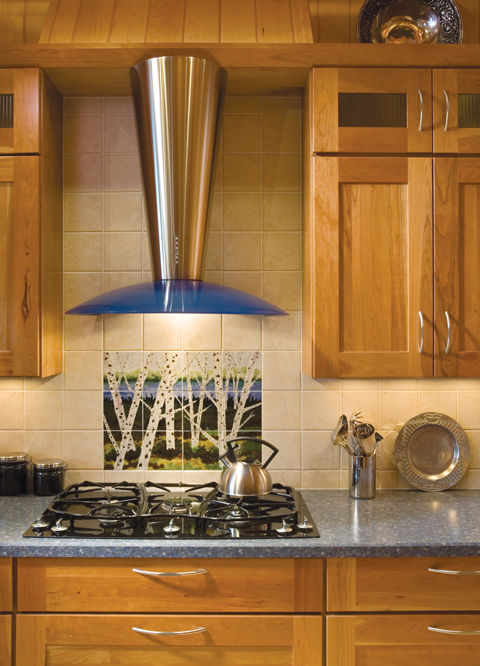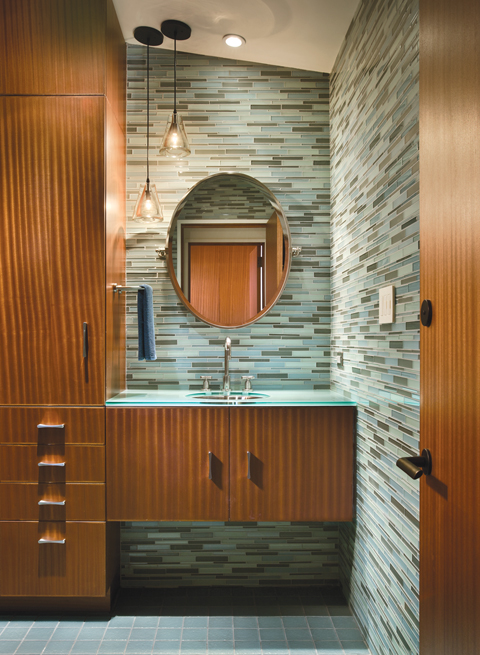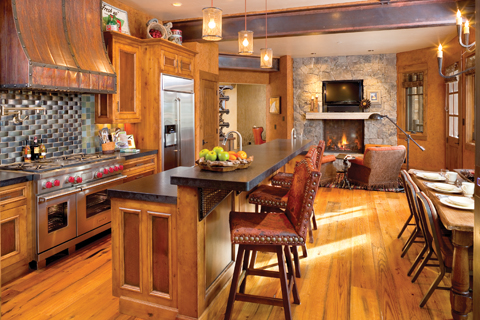Tile has been transforming living spaces, both interior and exterior, since ancient times. Simple, functional clay tiles were in use more than 7,000 years ago in what is now known as the Holy Land. Early Egyptians were the first to use glazed tile to enhance their architecture. Tile making eventually made its way to Europe, notably to Spain and the Low Countries, via Persia and North Africa. The Spanish conquistadors brought decorative tile to Colonial America. At the turn of the 20th century, there was increased concern about hygiene so tile began to appear in kitchens, bathrooms, and subways.
Today there is virtually a tile for every style, taste, and budget. The list of materials used to make tile has expanded far beyond its clay origins to include stone, glass, porcelain, ceramic, glass, metal, concrete, cork, and rubber. Tile is practical and durable in floors and walls, and in its most decorative form it can enhance an architectural feature, add visual interest to a space, and add flair to your chosen design style.

Riverbend Timber Framing/photo by Roger Wade
Kitchen Pizzazz
With today’s open floorplans, especially in log and timber homes, there is plenty of opportunity to enhance your design style and embellish the structure of your home. Coordinating your tile choices throughout your home’s public areas will add a sense of unity to the various living spaces. Since you will most likely use more tile in your kitchen than anywhere else, that’s the ideal place to start.
Nothing adds pizzazz to a kitchen more than a stunning tile backsplash. With your cabinets and countertops chosen, you’ll want to look for a backsplash that ties the two together. If your counters and cabinets are very detailed, you might want to consider a solid or subtly patterned tile for the backsplash so the room doesn’t look too busy. For example, subway tile has been around since the turn of the 20th century and is more popular now than ever before. Traditionally glazed ceramic, today’s subway tile comes in a variety of materials, from glass to metal to porcelain, in a wide variety of solid colors. They can be installed in a brick pattern, stacked one on top of the other, or even laid in a herringbone pattern for extra visual interest.
With simple cabinets and a minimally patterned countertop, you can select a more detailed backsplash, perhaps using a colorful mosaic or tiles featuring animals or plants that work with your overall decorating style. It might be over the top to fill the backsplash with figurative tiles, but interspersing these tiles in a subtly colored field of tiles will not only make the special tiles stand out but will save you some money.
If you want to add a bit of extra shine to your backsplash, metal tiles will do the trick. Stainless steel and copper, both polished and matte, are very popular kitchen materials. You can go bold with an all-metal tile backsplash or look for a mosaic that includes metal tiles in its pattern. If you have chosen stainless steel appliances, you might want to stay with the same metal in your backsplash. Stainless steel tiles will contribute to a more modern style of décor; they look beautiful when placed against a dark gray or black countertop with stained or painted cabinets. Copper tiles will add a lot of warmth to a kitchen, especially when paired with a copper farm sink and pot rack.
Fireplace Fantasy
Stone fireplaces abound in all types of homes but are especially prevalent in log and timber dwellings. Using tile on the fireplace, either as an accent or on the whole structure, is another option that can add to your home’s unique style. To enhance Spanish or Mexican-style décor, perhaps start with a stucco finish on the fireplace and add a row or two of colorful glazed tiles around the hearth or under the mantel. The tiles can be bright, solid colors or elaborately patterned, depending on your taste.
Arts & Crafts style is well known for its use of tile, especially on fireplace surrounds. Today, there are many skilled tile makers around the country who create spectacular tiles reminiscent of those found in homes at the turn of the 20th century. Both colors and patterns are taken from nature and readily complement the wood in a log or timber home.
For a more contemporary look, consider tiling your fireplace from floor to ceiling in porcelain, ceramic, or even concrete tile. You can look for tiles that resemble natural stone or go bold with a ceramic tile with a subtle metallic glaze.
If you decide to add tile to your fireplace, make sure it complements the tile you selected for your kitchen, particularly if you have an open floorplan.

Olson Kundig Architects/photo by Roger Wade
Bathing Beauty
Since they are not visible from the public spaces, you can have a bit more fun with the tile in your bathrooms. The sky is truly the limit when it comes to the possibilities for bathroom tile. Most tile manufacturers produce families of coordinated tiles in various shapes and sizes, which makes it easy to create a cohesive look in your bathroom. Or, take the more adventurous approach and mix and match colors and finishes from different companies.
Selecting tile for the floor is the best place to start. Keep in mind that tile can be very slippery when wet, so look for styles with a honed or textured finish. Running the same tile used on the floor through the walk-in shower will make the room look bigger, especially when combined with a glass enclosure. Tile made from river pebbles is another great choice for a shower floor. Your feet get a nice massage and your bathroom takes on a more rustic appeal. The same pebble tile can be used on a tub surround or as an accent on the walls.
A walk-in shower is the ideal place to display some gorgeous tile work. Glass is a very popular material for shower walls, in a shimmering mosaic pattern or with the clean lines of subway tile. The mosaic option is more practical because water and soap will not show as much as they will on a larger glass surface. Porcelain tiles with a matte finish may be easier to keep clean, but they do not reflect the light around the room.
An all glass tile shower surround can be quite expensive. To save money, consider using a porcelain subway tile or other less expensive tile on the surround and adding glass accents in horizontal or vertical stripes or in a random pattern. A shower storage shelf and seat can be highlighted with the more expensive tile. For a more rustic look, consider using a tile made to look like wood planks. It meets the non-slip requirement and has the look of a hardwood floor without the threat of water damage. Tile producers have been able to duplicate the look and colors or a number of species of wood, making it possible to coordinate your tile floor with the wood in the rest of the house. Natural stone, slate, or porcelain tile made to look like natural stone will enhance the room’s rustic appeal. Ceramic tile in natural colors or art tiles depicting elements from nature made ideal rustic accents.
The Sky’s the Limit
There are so many options on the market today that choosing tile for your home can be a daunting task. To make the selection process easier, get samples of all the materials you are considering and see how they play off each other. Most tile stores will give you samples to work with, as will granite or quartz manufacturers and cabinetmakers. If you’re not sure what look you’re going for, check out the hundreds of inspirational photos on www.houzz.com.
Some of the online tile outlets, such as www. susanjablom.com, will let you design your own mosaic to meet your precise expectations. You can order samples of any tile from any of these outlets, including www.modwalls.com and www.tilebar.com. Armed with your chosen samples and a tile design plan, your log or timber home will be ready for the spotlight.

